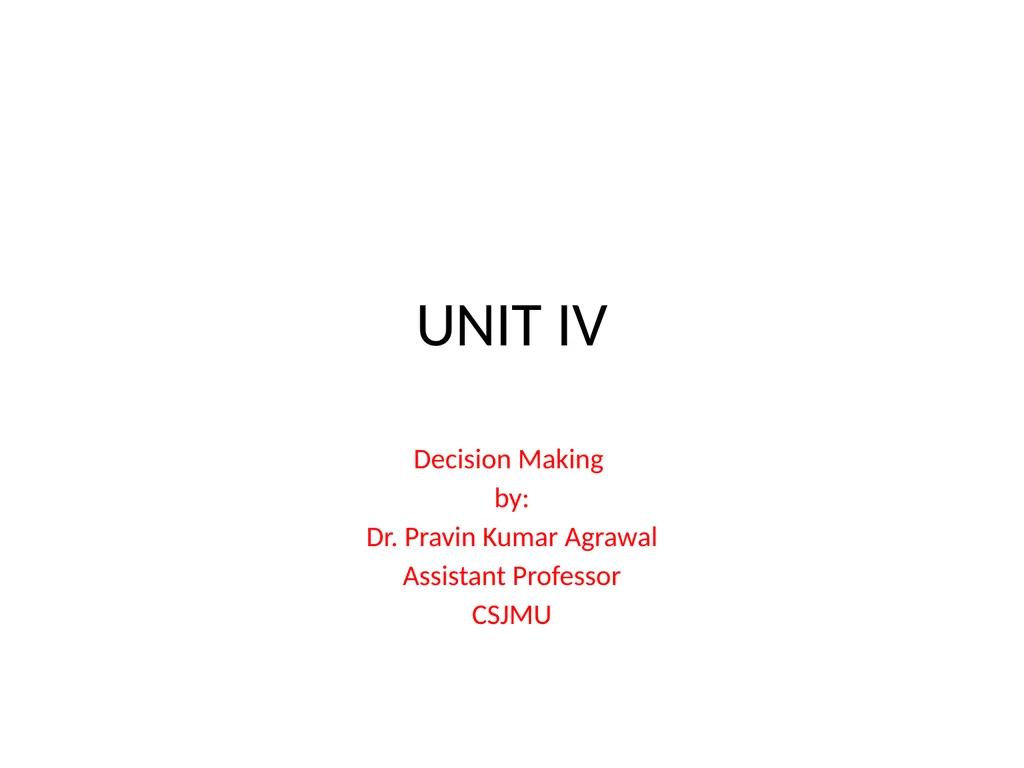UNIT IV Decision Making by: Dr. Pravin Kumar
Author : yoshiko-marsland | Published Date : 2025-05-07
Description: UNIT IV Decision Making by Dr Pravin Kumar Agrawal Assistant Professor CSJMU DecisionMaking Decisionmaking is needed whenever an individual or an organization private or public is faced with a situation of selecting an optimal or
Presentation Embed Code
Download Presentation
Download
Presentation The PPT/PDF document
"UNIT IV Decision Making by: Dr. Pravin Kumar" is the property of its rightful owner.
Permission is granted to download and print the materials on this website for personal, non-commercial use only,
and to display it on your personal computer provided you do not modify the materials and that you retain all
copyright notices contained in the materials. By downloading content from our website, you accept the terms of
this agreement.
Transcript:UNIT IV Decision Making by: Dr. Pravin Kumar:
UNIT IV Decision Making by: Dr. Pravin Kumar Agrawal Assistant Professor CSJMU Decision-Making Decision-making is needed whenever an individual or an organization (private or public) is faced with a situation of selecting an optimal (or best in view of certain objectives) course of action from among several available alternatives. For example, an individual may have to decide whether to build a house or to purchase a flat or live in a rented accommodation; whether to join a service or to start own business; which company's car should be purchased, etc. Similarly, a business firm may have to decide the type of technique to be used in production, what is the most appropriate method of advertising its product, etc. The decision analysis provides certain criteria for the selection of a course of action such that the objective of the decision-maker is satisfied. The course of action selected on the basis of such criteria is termed as the optimal course of action. Decision Alternatives Every decision-maker is faced with a set of several alternative courses of action A1, A2, ...... Am and he has to select one of them in view of the objectives to be fulfilled. States of Nature These are the future conditions that are not under the control of decision – maker. A state of nature can be the state of economy (e.g. inflation), a weather condition etc. The state of nature are usually not determined by the action of an individual or an organization, These are the results of an “act of GOD” Payoff A numerical value (outcome) resulting from each possible combination of alternatives and state of nature is called pay The payoff values are always conditional values because of unknown states of nature. Measured within a specified period (e.g. after one year). This period is called as the decision horizon. Payoff matrix Steps of Decision Making Process Identify and define the Problem. List all possible future events, called state of nature, which can occur in the context of the decision problem. Such events are not under the control of decision maker because they are erratic in nature. Identify all the courses of action (alternatives or decision choices) that are available to decision maker. The decision maker has control over these courses of action. Express the payoffs (pij) resulting from each pair of course of action and state of nature. These payoffs are normally expressed in monetary














